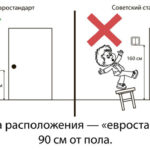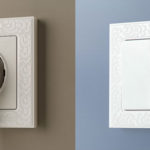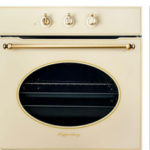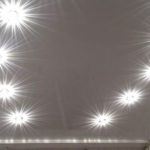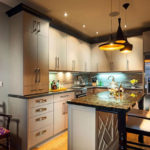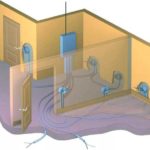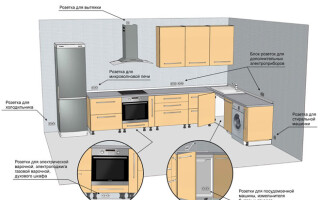The kitchen space includes appliances (stove, refrigerator, hood, microwave) that require separate electrical outlets. In typical apartments, you need to adjust the location of outlets when making repairs to the author's project. When drawing up a scheme, the parameters of the kitchen unit, the height and length of the walls, and the window units are taken into account. Before placing outlets in the kitchen, it is necessary to calculate the number of household appliances.
Contents .
Layout of kitchen socket outlets
When installing new kitchen furniture, you can use a ready-made professional diagram for the work. In the absence of a drawing, you need to think through the plan according to the parameters of the space.
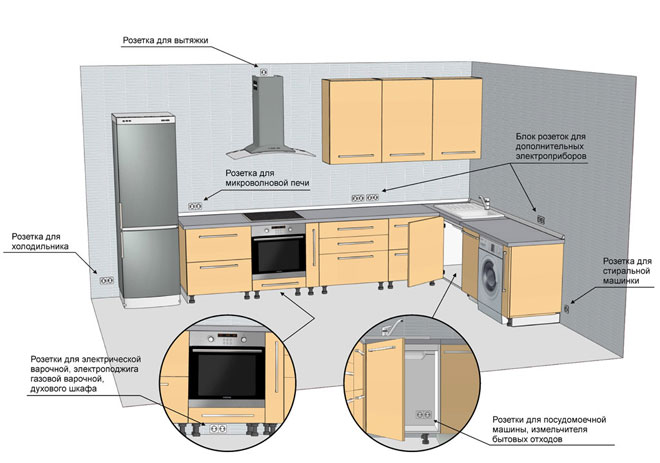
When drawing a diagram of the location of outlets in the kitchen, the size and configuration of the headset are taken into account. A detailed drawing of the furniture with the parameters, including small elements (drawers, shelves), is made for an accurate plan of the power supply sources for the appliances. Marking begins with large and built-in appliances that are not planned to move. The next step is marked outlets from medium and compact devices; the height and dimensions of the places of connection are indicated on the drawing.
Layout plan of electrical appliances for safe operation is regulated by regulatory documentation. Standards for the location of outlets are described in GOST 7396.1-89, 7397.0-89, 8594-80, data from SNiP 3.05.06-85.
The basic requirements regulate the height of the installation of outlets not more than 2 m in height from the floor covering. Electrical appliances are placed at a distance of no more than 1 m from the socket.
According to safety rules, the location of outlets in the kitchen should be at a sufficient distance from steam and water splashes, temperature changes.
The design and layout depend on the type of outlets that are available:
- overhead;
- angular;
- retractable;
- built-in (hidden).
Overhead type elements are standard, optimal for the connection of open type wiring. Designs are easy to install, but for kitchen areas are not the most harmonious.

Corner designs for power supply are popular in kitchen spaces, because they are functional, ergonomic. Elements are located at the joints of wall panels or walls and hanging racks. The slots for corner areas can be single or composed of several parts (modular), allowing the effective use of free space. Installation of structures is standard.
Products of the retractable type are advanced, used as an alternative version of extension cords. Suitable for simultaneous connection of several appliances. Designs are often hidden inside cabinets, countertops and protected from water, dust and dirt.
Built-in appliances are popular in modern interiors, they are aesthetically pleasing and allow for efficient use of space. The units are installed in countertops, cabinets and wall panels. Designs are hidden, if necessary pulled out.
In addition to standard systems in the spacious kitchen units, there is a need for additional outlets for video and audio devices and gadgets.
Number of outlets
The number of appliances in the kitchen unit is taken into account when making the layout. At least 3 additional outlets must be added to the standard number.
The general list of appliances includes:
- large appliances (refrigerator, TV, washing machine);
- compact appliances (coffee maker, kettle, mixer);
- built-in devices (timer, electronic scales).
Distances and locations
Before placing outlets in the kitchen, it is recommended to make a list of appliances and determine the overall power parameters.
According to the average characteristics of the appliances:
- The refrigerator consumes up to 1 kW;
- a water heater requires at least 1.5 kW;
- for a hob it is necessary from 1-1,5 kW;
- a dishwasher and washing machine needs about 1.5 kW;
- An oven requires at least 2.5 kW.
For the hob and oven, depending on their model and power consumption, you may need a separate cable from the circuit breaker with a wire cross section of 4-6 mm2. A socket outlet is not allowed in this case and the connection is made directly.
Small items (microwave, coffee maker, mixer, electric kettle) account for 300-800 kW according to the models. In spacious kitchens, space is allocated for a laptop, which consumes about 60-70 watts, and a TV, which requires 200-330 watts.
It is optimal to place the power connectors distributed over 3 levels of height.
The first is placed at a height of 15-30 cm, designed for bulky items.
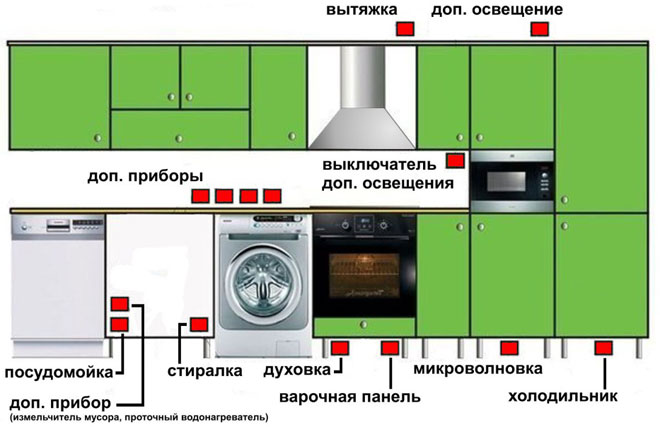
At the 2nd level, a larger volume of electrical appliances is installed. The space is occupied by the kitchen apron. The height of the connectors from the table is about 10-20 cm.
On the upper level are mounted power sockets for sconces, hinged appliances, etc. The height of the socket for the hood and light fixtures is from 2 m from the baseboard.
Socket outlet location for the refrigerator
Refrigerators, according to the requirements of the manufacturers, have cords of about 1 m in length. At the same time, it is forbidden to use an extension cord for safety reasons. Standards need to be taken into account when drawing up the layout of the appliances. It is important to place the power supply near the item and at the proper height.
Refrigerators that are installed separately from the unit can be plugged into the socket behind the appliance. However, it is recommended to make a small indentation (up to 5 cm). This will provide easy access to the connection of the appliance.
For built-in cold rooms, the power source is placed inside the cabinet, mezzanine, etc. The height parameters vary from 20 to 75 cm from the floor covering. The socket from the appliance is 10-20 cm.
Outlets in the work area and above the countertop
The bulk of electrical appliance outlets in the kitchen are placed above the worktop. Sockets are designed for compact appliances for cooking.
The number of devices is determined according to the customer's wishes and the size of the room. When determining the height of the outlet in the kitchen from the countertop, the comfort of connecting a food processor, mixer, kettle, etc. is taken into account. Up to 3 additional power sources can be added to the layout.
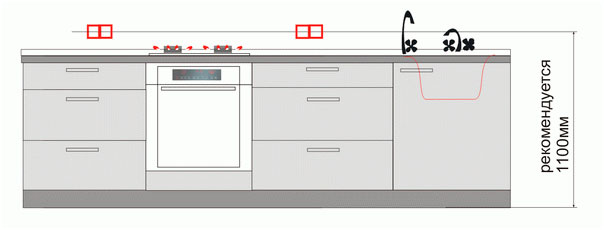
The popular variant of combining workspace outlets involves placing a set of connectors (3-4) in a condition of 1 m. It is important to take into account the regulatory distance to the water and gas pipes (not less than 50 cm).
Height of installation of elements from the floor varies (95-130 cm) depending on the project, the size of the room. In the instructions to the devices, the manufacturer prescribes the height of the power points with the laid flooring. During the overhaul, it is necessary to consider changes in the parameters of the floor level in accordance with the size of the tiles and possible insulation of the surface (15-30 mm).
In large rooms, several additional sockets are recommended at 300 mm from the floor under the TV, laptop, phone chargers, smartphones.
Socket for the hood
The correct location of the outlets in the kitchen for the hood depends on the configuration and location. According to the model, installation is done in different ways. Appliances are available that plug into a standard socket or appliances that only need a socket for the output of wires, cables.
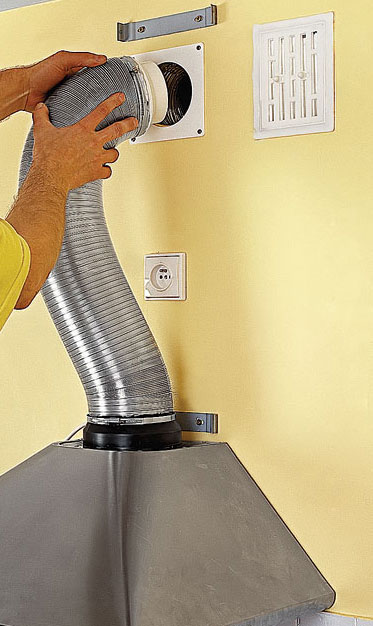
Widespread model with a vent pipe, which is hidden behind the cabinets. For the option is optimal to install a power source inside the rack. The design can also be installed above the cabinet, observing a distance of up to 21 cm from the device.
Open hoods do not require the installation of outlets, as they are connected directly to the power grid. However, when determining the location of the device outlet, it is important to follow the manufacturer's recommendations and safety precautions.
Hob and oven
Standard rules require separate electrical outlets for the oven and cooktop.
When placing the oven under the worktop, the power supply is mounted at the bottom, 180 mm from the floor surface. The space can be hidden later with drawers.
The next option involves placing the socket behind an adjacent cabinet unit. According to safety requirements, the power supply source is placed from the edge of the rack wall at a distance of at least 20 cm. The height of the power supply from the floor surface is 20-75 cm.
In projects that involve separate installation of the oven in the cabinet, the height of the sockets is calculated in accordance with the scheme. It is optimal to place the socket next to the appliance or under the oven (in a side drawer or a pull-out bottom unit). It is possible to displace the power supply under the hob to a height of 60-75 cm from the floor covering.
Dishwasher
The dishwasher is placed in the kitchen near the sink for a comfortable water supply. The connector is mounted inside the adjacent drawer or next to the water supply. The place is protected from the effects of vapors, water, temperature changes.
According to the standards, the socket is located 100-200 mm from the edge of the dishwasher appliance; the height is 200-400 mm from the floor surface.
For safety reasons it is forbidden to install power outlets behind the dishwasher, as for built-in appliances need enough space to preserve the aesthetic characteristics of the kitchen set.
Related articles:
